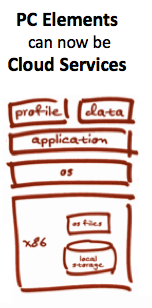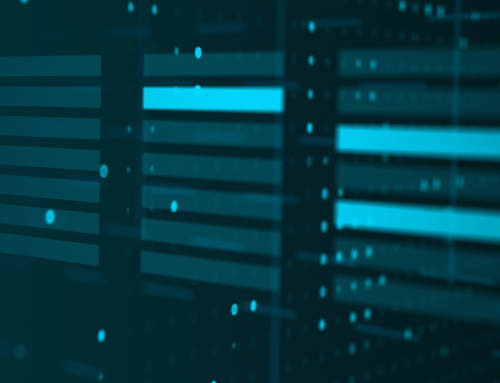Of all the interesting notions a new year brings with it – fresh starts, the chance to predict the future, etc. – one of the things I have come to appreciate is the ability to look back and learn.
In technology change is the only constant, with the velocity of change being one of the key variables.

The Basic Components of a Windows PC
And when it comes to velocity of change – nothing has hit our industry like the avalanche of cloud. It applies (or can, or should) to every use case, every industry, and in most cases every architecture for delivering digital services to end users. And that is cool stuff.
I remember the early days of server and then desktop virtualization vividly. While exciting, those days are merely footnotes to the true story of our generation. Cloud.
Liquidware started with a simple premise. Make delivering and managing Windows workspaces easier to manage at scale. The timing of our early years put us in the lead from day one in the VDI space. Most of the early, large, progressive projects used Liquidware to size, design, migrate & deploy, and then manage users, data, and applications. We had a front row seat to a really, really interesting transformation. We were successfully delivering Windows in new ways with both CAPEX and OPEX benefits.
An interesting phenomenon that is rarely, if ever, covered in the trade magazines is how tons of customers took what they learned with Liquidware in terms of how to do VDI right, and applied that to their physical desktops at massive scale. We saw ProfileUnity deployed across 50,000+ physical desktops at a large Telco. We saw FlexApp being deployed across both VDI and physical workstations at Health Care and Educational Customers. Stratusphere UX was the foundation for hundreds of Windows 10 migrations and hardware and image selection and design.
And then came Cloud…
VDI taught us to look at the PC as potentially separate objects. Hardware, OS, App, Profile, Data were each “elements” of the PC, but not the PC itself. Each was needed, and dependent on the other in physical PCs and non-persistent VDI taught us how to put it all back together.

Cloud, however, has taught us that these are not “elements”, but “services”. Remember this – it’s the whole thing. The parts that used to make up a desktop, or a PC, or workstation – are now, or better said, can now be services.
Liquidware helps enterprise administrators deliver Windows workspace services from the Cloud, at scale.
Let’s be clear, physical desktops, RDSH, and on-premises VDI are not going anywhere anytime soon but DaaS is now easier than ever and the industry is seeing significant adoption that cannot be ignored. In fact, we suspect many HYBRID deployments will be the norm with Desktop Disaster Recovery enabled by AWS S3, WorkDocs, and ProfileUnity becoming the standard way to securely backup the stuff you care about across your Physical and VDI PC Fleets – without the need for infrastructure. Cloud + physical and Cloud+VDI are things we will try successfully now.
We have strategically built out a portfolio of new features across ProfileUnity, FlexApp, and Stratusphere UX that applies to the offerings from Amazon Web Services – namely AWS WorkSpaces, Appstream2.0, and WorkDocs. Together the visibility, transit and migration, user environment management, and application delivery provided to enterprise customers not only meets, but exceeds those stacks offered by Citrix, VMware,
and Microsoft. Your PC elements, now services, are available from the Cloud – by consuming core AWS services with LW services providing the management services layer

AWS is your cloud hardware, Workspaces delivers Windows, AppStream2.0 + FlexApp deliver your context aware applications, ProfileUnity + S3/WorkDocs deliver your profile and data services, all cloud native. StratusphereUX is your insurance policy.
Together, there is no full stack that has better Windows Desktop (AWS Workspaces), Data (AWS S3 + WorkDocs) and Application (AWS Appstream2.0) core services with the industry gold standard UEM (ProfileUnity), Layering (FlexApp), and Visibility
(Stratusphere UX). These solutions have been used across physical, published, virtual, and now cloud desktops, at millions of seats of scale, for nearly a decade.
Why stay on the capital chasing and architectural treadmill of on-premises VDI?
Every single element of a Windows workspace can be more efficiently, securely, and flexibly delivered from the Cloud. What I learned in 2017 is DaaS (delivery of apps, data, operating systems, profiles, visibility as a service) is ready for prime time.
We know because we are now seeing some of the most progressive channel partners, VARs, system integrators, and alliance partners turning exploratory attention to the human capital services (smarts) that is needed to succeed with DaaS.
What’s even more flattering is the consistent mantra we are hearing that without Liquidware in your DaaS practice – don’t bother. The ability to size, tier, assess, migrate, mitigate, manage, publish apps, control images and sprawl (… the list goes on) – basically everything learned over a decade and millions of seats in the hand to hand combat market that was VDI – is now available as a service, at the service of the Channel.
We are already seeing some partners use our Stratusphere UX API to build cloud portals, or FlexApp + Amazon AppStream together delivery layered and published apps from the Cloud. ProfileUnity is helping manage user-state (profiles) in transit between instance types (bundles) and delivery type (migrating from on-premises XenDesktop to AWS WorkSpaces).
The channel will be the crucial in this. Not only do they hold the keys to the turn by turn directions to migrate from your current architecture to the cloud, they also hold the key to customers’ confidence.
My prediction for 2018 is simple. This confidence will expand. Virtually every on-premises VDI deployment, before it expands, or pays for renewals, will explore DaaS.
Liquidware is confident that the on-ramp we have forged and is being used for cloud on-boarding and enterprise operations by some of the most progressive companies across the globe – will be a valuable set of services for you as well as you explore, expand, and standardize…on cloud.
T.Rex
2018







[…] In a recent blog post J. Tyler Rohrer, co-founder of Liquidware, discussed how channel partners can benefit from embracing DaaS in order to deliver the ultimate next-generation desktop for their customers. You can view the post here: https://blog.liquidware.com/2018/01/05/daas-decoded-how-partners-are-going-to-benefit/ […]
[…] In a recent blog post J. Tyler Rohrer, co-founder of Liquidware, discussed how channel partners can benefit from embracing DaaS in order to deliver the ultimate next-generation desktop for their customers. You can view the post here: https://blog.liquidware.com/2018/01/05/daas-decoded-how-partners-are-going-to-benefit/ […]
[…] In a recent blog post J. Tyler Rohrer, co-founder of Liquidware, discussed how channel partners can benefit from embracing DaaS in order to deliver the ultimate next-generation desktop for their customers. You can view the post here: https://blog.liquidware.com/2018/01/05/daas-decoded-how-partners-are-going-to-benefit/ […]
[…] In a recent blog post J. Tyler Rohrer, co-founder of Liquidware, discussed how channel partners can benefit from embracing DaaS in order to deliver the ultimate next-generation desktop for their customers. You can view the post here: https://blog.liquidware.com/2018/01/05/daas-decoded-how-partners-are-going-to-benefit/ […]
[…] In a recent blog post J. Tyler Rohrer, co-founder of Liquidware, discussed how channel partners can benefit from embracing DaaS in order to deliver the ultimate next-generation desktop for their customers. You can view the post here: https://blog.liquidware.com/2018/01/05/daas-decoded-how-partners-are-going-to-benefit/ […]
[…] a recent blog post, J. Tyler Rohrer, co-founder of Liquidware, discussed the key trends that channel partners should […]
[…] a recent blog post, J. Tyler Rohrer, co-founder of Liquidware, discussed the key trends that channel partners should […]